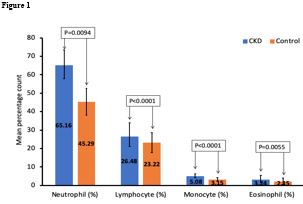Evaluation of hematological parameters and hemodialysis outcomes in patients with chronic kidney disease from north Gujarat: A prospective study
Abstract
ABSTRACT
Background: As chronic kidney disease (CKD) progresses the changes in hematological parameters become more evident. The present study aimed to determine the changes in hematological parameters and to evaluate effect of hemodialysis on the levels of serum creatinine and urea in patients with CKD from north Gujarat.
Materials and methods: A prospective cross-sectional study conducted in patients with CKD who were on hemodialysis, age between 30 to 70 years, serum creatinine level more than 1.5 mg/dL. The hematological tests were carried out in 50 patients with CKD and they were compared with 50 age and sex matched controls. All hematological parameters were measured. Serum creatinine and urea were estimated before and after hemodialysis.
Results: The mean age and gender was comparable between the groups. The hemoglobin, red blood cell count, packed cell volume, mean cell volume, mean cell hemoglobin, mean cell hemoglobin concentration and platelets were significantly lower in CKD group compared to control group (P<0.05). However, the mean neutrophil, lymphocyte, monocyte, and eosinophil count were significantly higher in patients with CKD compared to controls (P<0.05). The mean serum creatinine was higher in CKD group and significantly reduced after hemodialysis (11.61 mg/dL vs. 5.53 mg/dL; P<0.0001). Similarly, the mean urea concentration was higher in CKD group and significantly reduced after hemodialysis (143 mg/dL vs. 38.47 mg/dL; P<0.0001).
Conclusion: Hematological parameters can be used as markers in patients with CKD and hemodialysis is an effective treatment in reducing serum creatinine and urea in patients with renal failure from north Gujarat.
Keywords: hemoglobin, renal failure, post-hemodialysis, hemoglobin
Downloads
References
1. Varma P. Prevalence of chronic kidney disease in India - Where are we heading? Indian J Nephrol 2015; 25: 133-5.
2. Rajapurkar M, Dabhi M. Burden of disease - Prevalence and incidence of renal disease in India. Clin Nephrol 2010;74 (Suppl 1): S9-12.
3. Eduardo OC, Kaue A, Idania AA, Stein V, dos Santos GA. Influence of hemodialysis on the plasma concentration of adenosine deaminase in patients with chronic kidney disease. J Bras Patol Med Lab 2015; 51: 153-7.
4. Hsu CY, Bates DW, Kuperman GJ, Curhan GC. Relationship between hematocrit and renal function in men and women. Kidney International 2001; 59: 725-31.
5. Locatelli F, Pozzoni P, Del VL. Recombinant Human Epoietin beta in the treatment of renal anemia. Ther Clin Risk Manag 2007; 3: 433-9.
6. Katz I. Kidney and kidney related chronic diseases in South Africa and chronic disease intervention program experiences. Advances in chronic kidney disease 2005; 12: 14-21.
7. Khasawnah N, Abeeleh JA. Hematological and biochemical findings among Jordanian patient with end stage renal disease. Eur Sci J 2015; 11: 135-40.
8. Hassen HF, Al-Lami MQD, Al-Saedi AJH. Evaluation some Biochemical Levels in Patients undergoing Hemodialysis in Baghdad Governorate. J Adv Lab Res Biol 2018; 9: 50-7.
9. Shekhar S, Singh RR, Sinha R, Tripathy S. Effect of hemodialysis on renal profile in chronic renal failure patients at a tertiary care centre. Int J Clin Biochem Res 2021; 8: 57-61.
10. Nisha R, Srinivasa Kannan SR, Thanga Mariappan K, Jagatha P. Biochemical evaluation of creatinine and urea in patients with renal failure undergoing hemodialysis. J Clin Path Lab Med 2017; 1: 1-5.
11. Meenakshi GG. Effect of dialysis on certain biochemical parameters in chronic renal failure patients. Int J Contemp Med Res 2016; 3: 2869-71.
12. Habib A, Razi A, and Sana R. Hematological changes in patients of chronic renal failure and the effect of hemodialysis on these parameters. Int J Res Med Sci 2017; 5: 4998-5003.
13. Emmanuel IO, Getrude UO, Grace IA. Hematological changes in patients of chronic kidney disease in Umuahia, Abia State, Nigeria. Curr Trends Biomedical Eng & Biosci 2018; 11: 555805
14. Aruna G, Shabana . Evaluation of minerals, urea, and creatinine in chronic renal failure. Int J Clin Biochem Res 2019; 6: 447-51.
15. Gouva CH, Papavasiliou E, Katopodis KP, Tambaki AP, Christidis D and Tselepis AD. Effect of erythropoietin on serum PAFacetylhydrolase in patients with chronic renal failure. Nephrol dial transplant 2006; 21: 1270-77.
16. Wasti AZ, Sumaira I, Naureen F and Saba H. Hematological disturbances associated with Chronic Kidney Disease and kidney transplant patients. Int J Adv Res 2013; 1: 48-54.
17. Yoshitomi R, Nakayama M, Sakoh T, Fukui A, Katafuchi E, Seki M, et al. High neutrophil/lymphocyte ratio is associated with poor renal outcomes in Japanese patients with chronic kidney disease. Ren Fail 2019; 41: 238-43.
18. Mehdi WA, Al-Helfee W, Abd-W, and Dawood AS. Study of several antioxidants, total acid phosphatase, prostatic acid phosphatase, total and free prostate-specific antigen in sera of Man with chronic kidney failure. Kerbala Journal of pharmaceutical sciences 2012; 4: 155-65.
19. Cooper BA, Branley P, Bulfone L, Collins JF, Craig JC, Fraenkel MB, et al. A randomized controlled trial of early versus late initiation of dialysis. N Engl J Med 2010; 363: 609-19.

Copyright (c) 2021 Author (s). Published by Siddharth Health Research and Social Welfare Society

This work is licensed under a Creative Commons Attribution 4.0 International License.


 OAI - Open Archives Initiative
OAI - Open Archives Initiative


